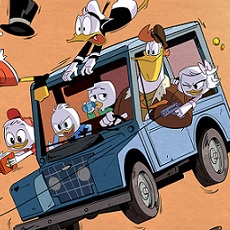Walt Disney Television/TMS Entertainment (1987), Buena Vista Home Entertainment (November 8, 2005), 3 discs, 618 mins, 1.33:1 original full frame ratio, Dolby Digital 2.0 Mono, Rated G (TV-Y), Retail: $34.99
Storyboard:
Inspired by the great comic stories of Carl Barks, Uncle Scrooge McDuck and his nephews embark on adventures that take them around the globe as they face off against a variety of adversaries.
The Sweatbox Review:
Walt Disney Comics Digest Number 44.
That is where it all started for me. This beautiful little 50-cent digest was published in 1973. It didn’t matter that it was printed on crummy newsprint, or that the pages had been recomposed from their original comic book printings. I was still three years away from being able to read, but even then I knew there was gold in those pages. There were four stories featuring the Disney ducks, meaning Donald and his three nephews— Huey, Dewey and Louie. I had probably seen Donald Duck on The Wonderful World Of Disney by this time, since with only two channels it was unlikely my family would have been viewing anything else on Sunday nights in 1973. The Donald Duck seen in that digest, however, was not quite the same quick-tempered, incomprehensible fellow seen in the cartoons. Oh, the comic book Donald had his share of tantrums, but he also had adventures. Donald was not really an adventure hero in the classical sense, but he and his nephews did have a tendency to find themselves mixed up with the most interesting characters in the comics.
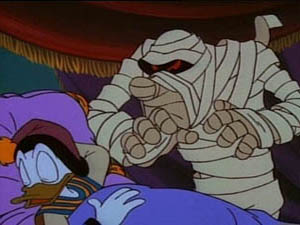
That digest held The Mummy’s Ring, In Ancient Persia, Luck Of The North, and The Pixilated Parrot. Those stories saw the ducks traveling the world and encountering various forms of danger. The Persia story was especially exotic, containing a foreign ruler, reincarnation, and mysticism. Each story, though, had terrific adventure, memorable stories, and numerous clever gags; and they were all written and drawn by Carl Barks. I credit his stories with first developing my appreciation for comics and storytelling in all forms. I paged through that digest dozens of times before I could even understand the words; and when I did learn to read, the stories only got better. Years later, I re-discovered the adventure stories of Carl Barks when Disney comics re-started publication, and I now have a nice collection of albums and books featuring the work of Mr. Barks.
Barks was a former story man at the Walt Disney studio, having started there in 1935 as an in-betweener in the animation department. His facility with gags and storytelling had Walt send him to the story department. (The Donald Duck short Modern Inventions has early examples of his gag work.). He left the studio in late 1942, just as it was coming under the control of the U.S. government during wartime. He wrote to a company that packaged comic books for publication, Western Publishing, to express interest in doing some work for them, and went on to be one of its most celebrated contributors. Dell published Western’s books for a long time, before Western created its own Gold Key and Whitman imprints.
Barks actually toiled in anonymity for many years, before his name became known to fandom in the 1960s. Until then, though, fans across the country knew that there was something unique about a number of the Donald Duck stories, not to mention those found in Walt Disney’s Uncle Scrooge. Barks had in fact created Donald’s fantastically wealthy Uncle Scrooge McDuck, appearing first in a 1947 Donald Duck comic book story and gaining his own series in 1952. He may have started as a supporting character, but before long Scrooge had become the protagonist in Barks’ adventure stories. Donald and the boys no longer had to get into trouble by themselves— Uncle Scrooge deliberately took them there! Over the next decade and a half, Barks sent the ducks all over the globe, encountering a dizzying array of crooks, swindlers, lost tribes, and hidden lands. Once, they even went to the moon. In 1991, Carl Barks was awarded the status of Disney Legend. Barks died in 2000, just a few months short of his 100th birthday.
His stories were not only well-crafted yarns— they were educational too. Barks used National Geographic Magazine for much of his inspiration, and his adventure stories often included subtle lessons in history, geography, and science. The richness of those stories influenced generations of comic book creators, not to mention a few animators.
And that, at last, brings us to DuckTales.
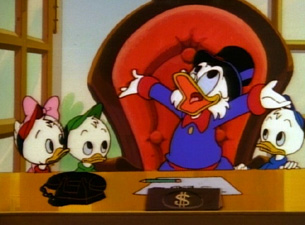
Back in the 1980s, The Disney company was looking to expand its presence on television, having only recently started producing Saturday morning animation with network shows Gummi Bears and The Wuzzles. Disney wanted to enter the syndication market, and was looking for a property that could support a daily cartoon show. A brilliant person somewhere in the company remembered the Barks “Uncle Scrooge” stories, and Disney’s TV people began to market their proposal to the syndication markets. They garnered a huge response, quickly clearing 87% of the US television markets on the basis of the Disney name and the show’s concept. They took two years then to prepare the initial 65 episodes, ensuring that the show had the best quality possible. While the production work was done in Los Angeles, the animation was done in Tokyo, but was of very high quality (for television). The resulting animation was relatively fluid (though certainly not feature quality), backgrounds were detailed, and special effects were utilized when appropriate. There was no immediate plan for the show to make money, as it was budgeted to break even. It was hoped that the quality of the show would see it become successful enough to turn a profit later. It was a gamble, back in those days of cheap and quick cartoon product.
Unbelievably, Uncle Scrooge had only appeared in theatrical animation twice, in Hamilton Luske’s 1967 cartoon Scrooge McDuck And Money, then in 1983’s Mickey’s Christmas Carol. While it was nice to get Uncle Scrooge on the big screen, that first cartoon was more interested in giving a lesson on economics than it was in adventure; and the Dickens adaptation did not exploit the true Uncle Scrooge character (although it was a very good cartoon in its own right). DuckTales remedied all that, offering television viewers an adventure every day after it debuted on September 11, 1987. Although the syndication market had become crowded by the time that DuckTales finally aired, the show distinguished itself by offering excitement without the violence and destruction seen in many other shows. It also looked way better than its competitors.

The ratings showed that Disney’s gamble had been a wise one. Within weeks, DuckTales became established as the most popular syndicated show ever.
DuckTales is based in Duckburg, USA, home of all the Disney ducks. Scrooge McDuck is the town’s most notable resident, as he is the world’s richest duck. He is a complex fellow— greedy and self-serving on the surface, yet possessing of a true humanitarian spirit. He cannot always see the right thing to do, but once it is pointed out to him he makes the right choice— even if he occasionally needs a nudge. One can never question his character, however. He rightfully credits his cleverness, toughness, and strong work ethic for gaining him his fortune. Scrooge acts as guardian for his three young great-nephews, while his nephew Donald is away with the navy serving on an aircraft carrier. Scrooge and his nephews enter into a constant stream of adventures that are often associated with his money— either searching for ways to increase it, or defying those out to get his fortune.

His nephews, Huey, Dewey, and Louie, are members of the Junior Woodchucks, a boy scout-like organization that has taught them ingenuity and the value of information and knowledge. Their resourcefulness is often responsible for getting Uncle Scrooge out of a jam, and their bravery (and perhaps their naiveté), drives more than one adventure forward. Scrooge and the boys have an ally from the comics as well, an eccentric inventor named Gyro Gearloose.
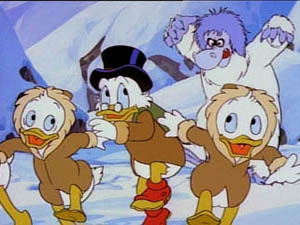
For all the discussion of Carl Barks, it does need to be noted that his work’s inspiration for the show did not guarantee a totally faithful adaptation. Donald Duck barely appeared after the first story, allowing the series to focus on Uncle Scrooge and the youngsters. New characters were also added to bring new aspects to the duck dynamic. Principle among these was Launchpad McQuack, an accident-prone and slow-on-the-draw (but brave) pilot. (Launchpad would find further life as Darkwing Duck’s sidekick on that 1991-93 superhero show.) Also introduced were the boys’ nanny Mrs. Beakly, and her own granddaughter, Webbigail Vanderquack. Little Webby joined the others on adventures and added a spunky female dynamic to many of the stories. Another Junior Woodchuck also appeared, an odd lad named Doofus.
DuckTales has several recurring villains, all creations of Carl Barks. The Beagle Boys are a gang of brotherly lifelong crooks who are always scheming to get into Scrooge’s money bin. Magica DeSpell is a sorceress whose prime interest is in obtaining Scrooge’s Number One Dime, the coin from which sprung all of his immense wealth. Flintheart Glomgold is Scrooge’s only serious rival for being the world’s richest duck, and he is not above treachery to gain the number one spot.
With the first season a great success, a second season of 35 episodes was produced, bringing the total to an even one hundred (counting a few longer specials as the single episodes they became once they were split up). The second season of episodes brought Gizmo Duck and a caveduck named Bubba to the series, but that’s a topic for a future review. Likewise, hopefully someday we will be discussing DuckTales The Movie: Treasure Of The Lost Lamp, the 1990 feature film that served as the series’ closer. DuckTales’ legacy went far beyond its second season and its movie, however. It was the first of several high-quality animated syndicated shows from Disney, including the aforementioned Darkwing Duck, as well as Chip ‘N’ Dale’s Rescue Rangers, Quack Pack, and The New Adventures Of Winnie the Pooh. It also led to the development of similarly finely produced shows from Warner Brothers, like Tiny Toon Adventures.
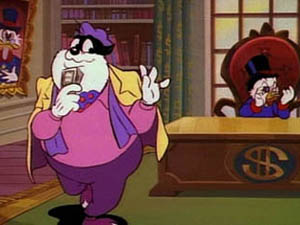
Looking at the show now after all these years, I found it to be properly aimed at a family audience. It is neither too childish for adults, nor too grown up for its own good. The animation is solid if not spectacular, and the stories are consistently fun and interesting. These are all-ages adventures that fortunately come close to evoking the spirit of their comic book origins, even as the show stands apart as a new creation.
This is a three-disc set, with nine episodes on each, for a total of twenty-seven adventures. A lamentable exclusion from this set is the story that introduced the show, Treasure Of the Golden Suns. This was a single, extra-long special that was later split into five episodes. The resulting weeklong story saw Donald join the navy, and set up Uncle Scrooge’s taking over responsibility for the boys. After that, however, the DVD does include the next 27 episodes in airdate (not production) order, starting with Send In The Clones. (The episode Armstrong was actually the next one in the production order.) Clones is not really a good way to start, as it has a busy plot involving doppelgangers, Magica DeSpell, and the Beagle Boys. The next episode, Sphinx For The Memories, brings Donald back for a rare appearance and is the series’ requisite “mummy” episode. Launchpad, Gyro, and Doofus do not appear until the third episode, Where No Duck Has Gone Before.
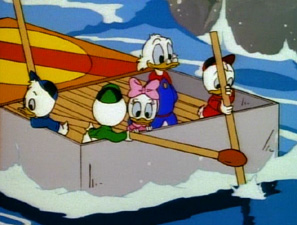
Two titles are giveaways in regards to being Barks adaptations. The Lost Crown Of Genghis Khan and Microducks From Outer Space are named for the comic book stories from which they came, although the latter is especially quite a loose adaptation. Closer to the source is Earthquack, which is based on Barks’ Land Beneath The Ground. Others, like The Curse Of Castle McDuck or Pearl Of Wisdom, are quite reminiscent of Barks adventures, although not out and out adaptations. I only wish they would have given us one more episode on this set, so that I could see Back To The Klondike, which was based on one of Carl Bark’s earliest and most celebrated Uncle Scrooge stories. Nevertheless, there are plenty of good ones in this set, and we shall get to the others later. Most of the episodes on this set are fully original, and a few do not even have Uncle Scrooge in them (e.g. Sir Gyro De Gearloose, Superdoo!). There is little doubt, however, that the series would have never come to be without the creations of the great Carl Barks— storytelling master.
Sources:
Carl Barks and the Art of the Comic Book, by Michael Barrier, 1981.
“Let Us Now Praise Famous Ducks”, by David HutchisonComics Scene Quarterly #2 (Volume 3, Series Number 13), 1988.
Is This Thing Loaded?
Fans will not be happy with the total lack of extras in this set. There is not much else to say, other than you may want to check out the upcoming Walt Disney Treasures: The Chronological Donald Volume 2. That set is supposed to contain a featurette called “The Art and Animation of Carl Barks”. It would have been at least as meaningful, and probably more so, to have included this featurette with DuckTales, and I am sorry that those who buy DuckTales but do not purchase the Treasures set will not be introduced to the influential and important cartoonist.

DuckTales Volume 1 does have Previews, of course. Included are an actual trailer for Chronicles Of Narnia: The Lion, The Witch And The Wardrobe, and the DVDs for Valiant, Toy Story 2, and the Muppet movies.
Even the menus are rather “blah”. They are static, and not all are even in the best focus. But… the episodes actually have chapter stops! And the show’s opening and credits get their own chapters! Well, that’s nice, at least.
Case Study:
Unlike prior packages that Disney has used for its TV shows, this one has been given slimcases. I was not initially too thrilled with the cover art on the outer box, since it seems so pedestrian, but the set does look nice once it is in your hands. I still feel that more could have been done, especially considering that the individual slimcases recycle art from prior VHS releases from well over a decade ago. It just makes it seem even more like Disney did not put too much effort into this release. The three discs are each single-sided, dual layered. No flippers, at least!
Ink And Paint:
Most fans may be satisfied if not overjoyed by these transfers. I have been spoiled recently reviewing some crisp 21st century cartoons, so maybe that is why these 1980s cartoons look so soft lacking in detail in comparison. At least they avoided doing any obvious edge enhancement. Light grain is apparent much of the time, and there are physical artifacts from the traditional animation process— occasional smudges, dust, etc. Overall, the episodes do look just “okay” at best, and they do pale in comparison to DVDs for more recent shows like Teen Titans or Kim Possible.
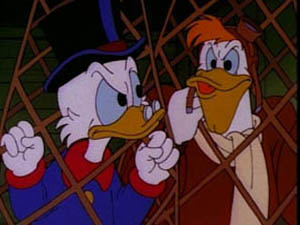
Scratch Tracks:
The Dolby Digital Mono sound is undistinguished, but serviceable. The sound is rather flat, but I suppose it is at least as good as what aired on television.
I was surprised when I heard the theme from the show for the first time in years. I had not been able to remember it, and now I know why. Mark Mueller created a pretty typical Eighties ditty with weak lyrics and jingle-level music. I was sure that DuckTales must have had a deservedly rocking theme, but I was mistaken.

Notable among the voice actors on DuckTales was Alan Young, reprising the role of Uncle Scrooge from 1983’s Mickey’s Christmas Carol. Animation legend June Foray did Mrs. Featherby as a concerned and loving lady, while her “Magica DeSpell” was closer to “Natasha Fatale” than “Granny”.
Only an English language track is offered, and only English subtitles for the hearing impaired.
Final Cut:
It is a shame that Disney did not do more for this release, seeing that this was such a landmark show creatively, commercially, and even historically. Still, it is wonderful to see the show on DVD at all, and it would be hard to not recommend a purchase. The set is very reasonably priced, and the stories are generally wonderful— especially for kids, but pretty enjoyable for adults too. If we had not been spoiled by so many beautifully remastered DVD sets the past couple of years, the dingy video and recycled packaging art would not be so much of a disappointment. It is a pity that Disney’s release of Spider-Man: The ’67 Collection looks better than their own flagship TV title DuckTales.
The exclusion of the opening story is a head-scratcher, but it was belatedly promised for the Volume 2 set.
So, caveats aside, fans of the show should love seeing it come out on DVD. For those that have not seen it, or for those contemplating making a purchase for their kids, the value of these stories inspired by the magic storytelling of Carl Barks is enough is make up for a lackluster presentation.
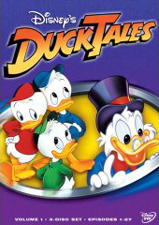 | ||
 |









